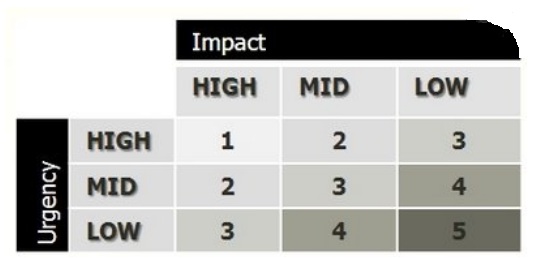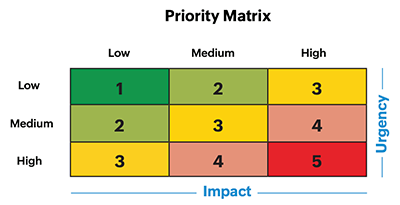

The impact is categorized into four levels. In an ITIL incident management priority matrix, impact is the potential financial, brand, or security damage caused by the incident on the business organization before it can be resolved. An example of this guidance is the following.

To be effective and give guidance to staff assigning an incident priority, you need to define what the criteria mean. In our ITIL incident management priority matrix example, we used critical, high, medium, and low as criteria with impact and urgency. Below is an ITIL incident management priority matrix example. In ITIL incident management priority is determined by using an ITIL incident management priority matrix. Making sure an appropriate priority is assigned to an incident is important for SLAs, response times, and service restorations. Incident response and escalations are based on the incident priority levels assigned. The incident priority is a matrix of impact and urgency. Urgency is how quickly incident resolution is required. The incident impact is the potential financial, brand, or security damage caused by the incident on the business organization before it can be resolved. The ITIL priority definition is of the incident is based on the impact and urgency of the issue. What is the priority definition in ITIL Incident Management? This work order of incident tickets is based on the priority assigned to the incident tickets. The work order of incident tickets will need to be determined. For each incident, a ticket is created in a ticketing application such as ServiceNow. It’s a bit unwieldy, but most SharePoint calculations are.Do you have an ITIL incident management priority matrix? Due to Help Desk resource constraints, not all incidents can be worked on simultaneously. This function takes a list of options and a number it returns the option that corresponds to the passed value. This can be done with multiple nested IF statements, but SharePoint provides the CHOOSE() function for just this purpose. Thirdly, we need to convert the resulting positional number to the correct Priority. If Impact were, say, 3 and Urgency were 2, this would result in:Īpplying that to the actual grid and we get “3 – Medium”.
#Itil priority matrix full#
The full equation is: ((Impact+Urgency)+((Impact-1)*3)-1) It’s simple enough, but a bit convoluted. We need some math to obtain the correct number based on the Impact and Urgency. Each one of these numbers would correlate to a specific Priority.

Secondly, imagine the Priority grid above replaced with numbers starting with “16” in the upper left and counting down, left-to-right, to “1” at the bottom right. This is done, as described above, with the LEFT() function. Our calculation is broken up into three parts.įirstly, we convert Impact and Urgency to their numerical equivalents. The last field, Priority, is calculated field that returns a “Single line of text”. In this example, since they’re the first characters, the LEFT function alone – as in, LEFT(Impact) and LEFT(Urgency) – is enough. The numbers are important, but their placement isn’t as long they’re consistent enough to tease out using SharePoint’s built-in functions. Firstly, of course, we need a field each for Impact and Urgency. These are simple multi-option drop-down fields with the following values: The chart is simple enough to navigate, but getting the calculation into SharePoint takes some finagling. Both Impact and Urgency can be one of four values (“Low” to “Critical”) and these convert to a priority in a non-linear cascade as follows: While each implementation may differ slightly in the number of options available, a common scenario is presented below. For example, a team using a SharePoint list to accept service requests may define the impact and urgency of those requests to determine a calculated In some cases you may want to implement this calculation directly within a SharePoint list, or, since this is likely a well-understood concept in the organization, apply a similar calculation to another process. Most ITIL-based tools (Remedy, ServiceNow, etc.) handle this conversion internally based on customer definitions. ITIL determines the Priority of an incident as a function of its Impact (its direct effect on business processes) and Urgency (the amount of delay that can be accepted before resolution).


 0 kommentar(er)
0 kommentar(er)
